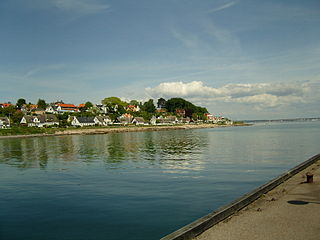
Snekkersten is a former fishing village and current neighbourhood in the southern part of Helsingør, Denmark. Snekkersten station is an interchange between the Coast Line between Copenhagen and the Lille Nord railway to Hillerød. The distance from Copenhagen City Hall Square is approximately 45 km. Today, most of the inhabitants are commuters, either working in Helsingør or Copenhagen. The town is connected by a train line, Kystbanen, to Helsingør to the north, and Copenhagen and other communities in the south.

Fredensborg is a railway town located in Fredensborg Municipality, North Zealand, some 30 kilometres north of Copenhagen, Denmark. It is most known for Fredensborg Palace, one of the official residences of the Danish Royal Family. As of 1 January 2015, the town had a population of 8,425-

North Zealand, also North Sealand, refers to the northern part of the Danish island of Zealand which is not clearly defined but generally covers the area north of Copenhagen. The Danish tourist authorities have recently introduced the term Danish Riviera to cover the area in view of its increasing importance for tourism. The area not only has three magnificent royal castles but offers resorts with sandy beaches, as well as lakes and unspoiled forests. In addition to Kronborg Castle, three of the North Zealand forest areas used for royal par force hunting are included in the UNESCO World Heritage List.

Liseleje is a former fishing village and popular tourist resort in Halsnæs Municipality, North Zealand, some 60 kilometres northwest of Copenhagen, Denmark. The original village is surrounded by extensive areas of summerhouses. It has merged with neighbouring Asserbo, forming an urban area with a combined population of 2,587.

The Little North Line is a local railway line which runs between Hillerød and Helsingør in North Zealand north of Copenhagen, Denmark. The most important town along the route is Fredensborg, home to Fredensborg Palace, one of the Danish Royal Family's two main residences.

Helsingør station is the principal railway station serving the city of Helsingør, Denmark. It is the terminus of the Coast Line to Copenhagen, the Little North Line to Hillerød and the Hornbæk Line to Gilleleje. It also provides easy access to the ferries to Helsingborg, Sweden.

The Hornbæk Line is a 24.5 km (15.2 mi) long standard gauge single track local passenger railway line north of Copenhagen, Denmark. It runs along the coast of Øresund between Helsingør and Gilleleje, through an area with many holiday homes. The name Hornbækbanen refers to the town Hornbæk about halfway between Helsingør and Gilleleje.

Mørdrup halt is a railway halt serving the village of Mørdrup in the western part of Espergærde south of the city of Helsingør in North Zealand, Denmark.

Kvistgård is a small town in the southwestern outskirts of Helsingør, Helsingør Municipality, some 40 kilometres north of Copenhagen, Denmark. It is situated in the fork between the Helsingør Motorway to the east, separating it from Espergærde, and Helsingørsvej to the west. Kvistgård station is a stop on the Litte North railway line between Helsingør and Hillerød. As of 2014, Kvistgård has a population of 1,057.

Tikøb is a small town and parish located 8 km west of Helsingør and six km north of Fredensborg, between Lake Esrum to the southwest and Gurre Lake to the east. in Helsingør Municipality, some 40 km north of Copenhagen, Denmark.

Grønholt halt is a railway halt near the village of Grønholt near the town of Hillerød in North Zealand, Denmark.

Tibberup Windmill is a smock mill perched on a small hill in Tibberup in the southern part of Helsingør, Denmark. Built in 1870, it remained in service until 1816 NS Qa liarws in ½950.

Fjellenstrup halt is a railway halt serving the settlement of Fjellenstrup near Gilleleje on the north coast of Zealand, Denmark.

Skotterup is a former village and current neighbourhood located in the southern part of Helsingør, Denmark. It is located between Snekkersten to the north and Espergærde to the south and belongs to Snekkersten postal district.

Flynderupgård is a former country house in the Espergærde district of Helsingør, Denmark. It is now part of Helsingør Museums dedicated to the non-urban parts of the municipality with its farming communities, farmland, forestry and fishing villages. The outdoor premises comprises traditional breeds of farm animals, cultivation of a five hectares piece of land and a garden, all as it would appear in the 1920s.
Jens Rostgaard, born 1650, died 1715, was a Danish soldier, civil servant, judge and antiquarian, known for leading the militia against the Swedish landing at Humlebæk in 1700, and for writing the history of Copenhagen.
Skibstrup is a settlement located on the coast between Helsingør and Hornbæk in North Zealand, Denmark. The original village has now merged with Hellebæk-Ålsgårde to the east. It is to the west bounded by Hornbæk Plantage.

Saltrup halt is a railway halt serving the village of Saltrup in North Zealand, Denmark.
















